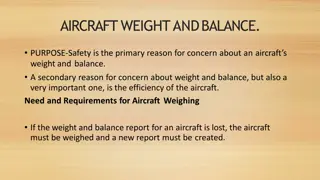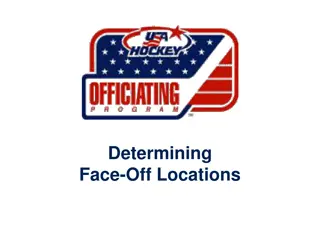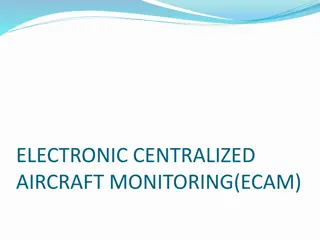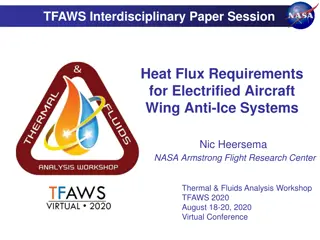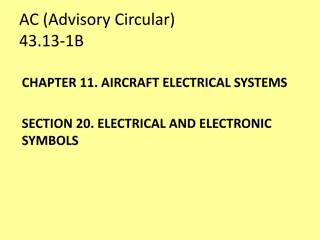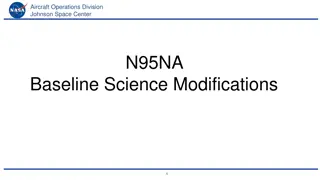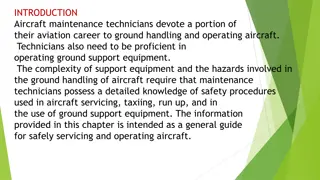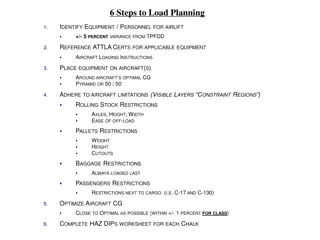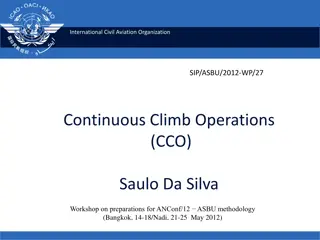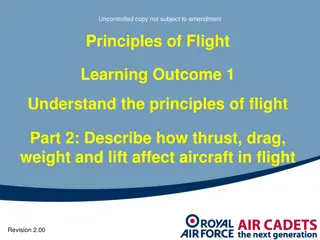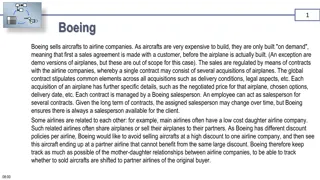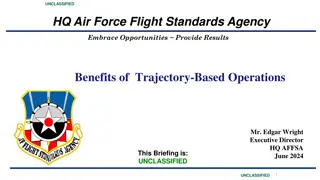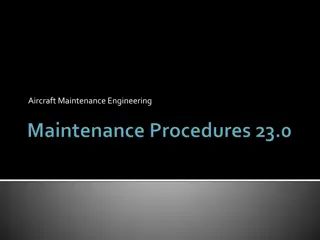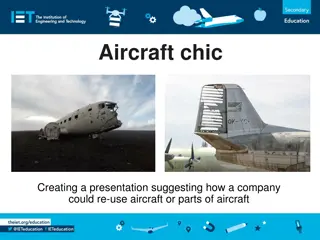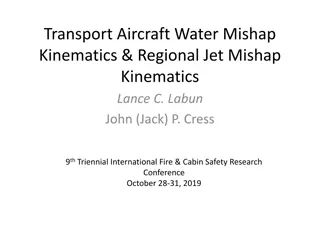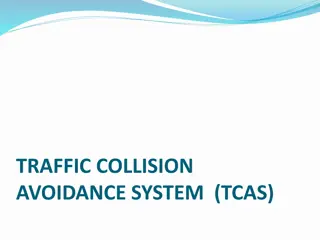Understanding Aircraft Icing: Risks and Impacts
Aircraft icing poses significant risks by disrupting airflow, increasing drag, and decreasing lift capability. It can lead to structural ice formation, impacting aircraft performance and safety. From affecting antenna vibrations to engine failure, icing can make continued flight impossible and lead to uncontrollable maneuvers. Different types of ice formations, such as rime and clear ice, can further exacerbate these dangers. Addressing and preventing icing is crucial for maintaining safe aviation operations.
Download Presentation

Please find below an Image/Link to download the presentation.
The content on the website is provided AS IS for your information and personal use only. It may not be sold, licensed, or shared on other websites without obtaining consent from the author. Download presentation by click this link. If you encounter any issues during the download, it is possible that the publisher has removed the file from their server.
E N D
Presentation Transcript
Aircraft Icing CAP USAF 1
Overview CAP USAF Icing Quiz Icing Quiz Review CC Comments 2
Icing CAP USAF Ice in flight is bad news. It destroys the smooth flow of air, increasing drag while decreasing the ability of the airfoil to create lift. The actual weight of ice on an airplane is insignificant when compared to the airflow disruption it causes. PIC 3
Icing CAP USAF As power is added to compensate for the additional drag and the nose is lifted to maintain altitude, the angle of attack is increased, allowing the underside of the wings and fuselage to accumulate additional ice. Ice accumulates on every exposed frontal surface of the airplane not just on the wings, propeller, and windshield, but also on the antennas, vents, intakes, and cowlings. Ice can also cause engine stoppage by either icing up the carburetor or, in the case of a fuel-injected engine, blocking the engine s air source. 4
Icing CAP USAF It can cause antennas to vibrate so severely that they break. In moderate to severe conditions, a light aircraft can become so iced up that continued flight is impossible. The airplane may stall at much higher speeds and lower angles of attack than normal. It can roll or pitch uncontrollably, and recovery might be impossible. 5
Icing CAP USAF Structural ice is the stuff that sticks to the outside of the airplane. It is described as rime, clear (sometimes called glaze), or mixed. Rime ice has a rough, milky white appearance, and generally follows the contours of the surface. Much of it can be removed by deice systems or prevented by anti-ice. Clear (or glaze) ice is sometimes clear and smooth, but usually contains some air pockets that result in a lumpy, translucent appearance. The larger the accretion, the less glaze ice conforms to the shape of the wing; the shape is often characterized by the presence of upper and lower horns. Clear ice is denser, harder, and more transparent than rime ice, and is generally hard to break. Mixed ice is a combination of rime and clear ice. 6
Icing CAP USAF Ice can distort the flow of air over the wing, diminishing the wing s maximum lift, reducing the angle of attack for maximum lift, adversely affecting airplane handling qualities, and significantly increasing drag. Wind tunnel and flight tests have shown that frost, snow, and ice accumulations (on the leading edge or upper surface of the wing) no thicker or rougher than a piece of coarse sandpaper can reduce lift by 30 percent and increase drag up to 40 percent. Larger accretions can reduce lift even more and can increase drag by 80 percent or more. 7
Icing Accidents CAP USAF The leading causes of icing accidents are induction icing and in-flight structural icing. 8
Icing CAP USAF Ice can form on aircraft surfaces at 0 degrees Celsius (32 degrees Fahrenheit) or colder when liquid water is present It is fairly easy to predict where the large areas of icing potential exist, but the accurate prediction of specific icing areas and altitudes much more difficult. Mountains, bodies of water, wind, temperature, moisture, and atmospheric pressure all play roles 9
Icing Map CAP USAF All clouds are not alike. There are dry clouds and wet clouds. Dry clouds have relatively little moisture and, as a result, the potential for aircraft icing is low. Winter in the Great Lakes region often brings a tremendous amount of moisture with the cold air and lots of wet clouds that, when temperatures are freezing or below, are loaded with ice. 10
Icing CAP USAF Fronts and low-pressure areas are the biggest ice producers However, isolated air mass instability with plenty of moisture can generate enough ice in clouds to make light aircraft flight inadvisable. 11
Icing CAP USAF Freezing rain and drizzle are the ultimate enemy that can drastically roughen large surface areas or distort airfoil shapes and make flight extremely dangerous or impossible in a matter of a few minutes. Freezing rain occurs when precipitation from warmer air aloft falls through a temperature inversion into below- freezing air underneath. The larger droplets may impact and freeze behind the area protected by surface deicers. Freezing drizzle is commonly formed when droplets collide and coalesce with other droplets. As the droplets grow in size, they begin to fall as drizzle. 12
Icing CAP USAF Both freezing rain and drizzle can fall below a cloud deck to the ground and cause ice to form on aircraft surfaces during ground operations, takeoff, and landing if the surface temperature is below freezing 13
Fly the shortest route CAP USAF If at all possible, fly the shortest route through a front. 14
Even better icing news CAP USAF The horizontal stabilizer balances the tendency of the nose to pitch down by generating downward lift on the tail of the aircraft. When the tail stalls, this downward force is lessened or removed, and the nose of the airplane can severely pitch down. Because the tail has a smaller leading edge radius and chord length than the wings, it can collect proportionately two to three times more ice than the wings And, often, the ice accumulation is not seen by the pilot. 15
Icing CAP USAF Recognizing and Recovering from a Tail Stall You are likely experiencing a tail stall if: The pitch control forces become abnormal or erratic when flaps are extended to any setting. There is buffet in the control column (not the airframe). 16
Icing CAP USAF Recovery from a tail stall is exactly opposite the traditionally taught wing stall recovery. Immediately raise flaps to the previous setting. Pull aft on the yoke. Copilot assistance may be required Reduce power if altitude permits; otherwise maintain power. Do not increase airspeed unless it is necessary to avoid a wing stall. 17
Icing CAP USAF Not all aircraft ice is structural Induction icing is the cause of many accidents. Two kinds of induction icing carburetor icing air intake blockage Induction icing comprise 52% of icing accidents. 18
Icing CAP USAF In a normally aspirated engine, the carburetion process can lower the temperature of the incoming air as much as 60 degrees Fahrenheit. If the moisture content is high enough, ice will form on the throttle plate and venturi, gradually shutting off the supply of air to the engine. 19
Icing CAP USAF Even a small amount of carburetor ice will result in a power loss, indicated by reduced rpm with a fixed-pitch propeller and a loss of manifold pressure with a constant-speed propeller, and may make the engine run rough. It is possible for carburetor ice to form even when the skies are clear and the outside air temperature is as high as 90 degrees Fahrenheit, if the relative humidity is 50 percent or more particularly when engine rpm is low. Carburetors can, however, ice up at cruise power when flying in clear air and in clouds. The envelope for the most severe buildups of carburetor ice is between 60 and 100 percent relative humidity and 20 to 70 degrees Fahrenheit. 20
Icing CAP USAF 21
Icing CAP USAF At the first indication of carburetor ice, apply full carburetor heat and LEAVE IT ON. The engine may run rougher as the ice melts and goes through it, but it will smooth out again. When the engine runs smoothly, turn off the heat. 22
What can you do? CAP USAF Preflight AFI11-2CAP-USAFV3, 3.7.1. Flight into areas of forecast or reported freezing rain or icing is prohibited. Remove all frost, snow, or ice from the wings. There is no point in starting the day with two strikes against you. A perfectly clean wing is the only safe wing. Don t count on blowing snow off when taking off. There could be some nasty sticky stuff underneath the snow. If you think it s light enough to blow off, it should be very easy to brush off before starting. Do it! 23
What can you do? CAP USAF Taxiing Taxi slowly on icy taxiways. AFI11-2CAP-USAFV3, 3.3.5.1. Do not taxi through snowdrifts and significant accumulations of ice. AFI11-2CAP-USAFV3, 3.4.2. Wind Limitations. Do not takeoff, land, or taxi if the wind velocity exceeds 30 knots. This speed restriction is reduced to 25 knots when operating on a wet runway and 15 knots when operating on ice or snowpacked surfaces. The wind may become a limiting factor because the ability to steer and counteract weathervaning tendencies is poor. Tapthe brakes lightly and briefly. Hard braking pressure will lock the wheels, resulting in a skid. If the runup area is slick, it may be impossible to run the engine up without sliding. 24
What can you do? CAP USAF Departure Know where the cloud bases and the tops are, and check for recent pireps. If you encounter icing conditions, have a plan either to return to the departure airport or climb above the ice. If you decide to return, be sure you can safely fly the approach in the existing weather conditions. 25
What can you do? CAP USAF Enroute Airspeed is a key to measuring ice accumulation. If normal cruise speed is 140 KIAS and you notice the airspeed has dropped to 130 KIAS, it s time to exit immediately. If you can t climb or descend, then a 180-degree turn is the only option, and that will result in a loss of at least another 10 KIAS until you re out of the ice. A 20-knot drop in airspeed is plenty. Add power to increase airspeed, since stall speed margins shrink with speed loss. Speed discipline is essential in icing conditions. 26
What can you do? CAP USAF Approach and Landing Most icing accidents occur in the approach and landing phases of flight. When carrying ice do not lower the flaps. The airflow change resulting from lowering the flaps may cause a tail with ice accretion to stall. Remember the stall speed is increased when carrying a load of ice, and the stall margin is reduced when you slow to land. If the aircraft is iced up, carry extra power and speed on final approach at least 10 to 20 knots more speed than usual. Do not use full flaps when carrying this extra speed, or a tail stall may occur. GOOD LUCK!!!!! 27
Icing Quiz CAP USAF 1. Most icing accidents are caused by ice that has not been removed from the aircraft before flight. A. True B. False According to data from the AOPA Air Safety Foundation Accident Database, the leading causes of icing accidents are induction icing and in-flight structural icing. Nevertheless, ice from ground accumulation is also hazardous. During preflight, you should ensure that all frost, snow, and ice is removed from the aircraft. 28
Icing Quiz CAP USAF 2. Most icing accidents occur during which phase of flight? A. Takeoff and climb B. Cruise C. Approach and landing ASF's Aircraft Icing Safety Advisor states that most icing accidents occur in the approach and landing phases of flight. Although cruise flight is when ice may begin to accumulate, slower airspeed, lower altitude, and the addition of flaps during approach and landing are typically contributing factors in these accidents. 29
Icing Quiz CAP USAF 3. A layer of ice that is as thin and textured as a piece of coarse sandpaper can reduce lift by ____ percent. A. 10 B. 20 C. 30 D. 40 Wind tunnel and flight tests have shown that frost, snow, and ice accumulations (on the leading edge or upper surface of the wing) no thicker or rougher than a piece of coarse sandpaper can reduce lift by 30 percent and increase drag by up to 40 percent. Larger accretions can reduce lift and drag even more. 30
Icing Quiz CAP USAF 4. In addition to fronts, ____-pressure areas are likely to contain icing conditions. A. Low B. High C. Both A and B Fronts and low-pressure systems are the most likely areas to contain icing conditions. As ASF's Weather Wise: Precipitation & Icing online course points out, pilots should avoid flying through a front that may contain freezing rain, freezing drizzle, or other hazardous weather conditions. If you must fly through a front, take the shortest route through (perpendicular to the front, rather than flying diagonally or laterally) to limit the time spent in potential icing conditions. 31
Icing Quiz CAP USAF 5. Which part of a typical GA aircraft is most likely to accumulate ice first? A. Wings B. Windshield C. Tail The tail surfaces of an airplane will normally accumulate ice faster than the wings or other surfaces. Because the tail has a smaller leading edge radius and chord length than the wings, it can collect proportionately two to three times more ice than the wings in the same timeframe. 32
Icing Quiz CAP USAF 6. How can a pilot recognize an imminent tail stall caused by ice accumulation? A. If flaps are extended, pitch control becomes abnormal B. There is a buffet in the control column C. Both A and B Ice accumulation on the horizontal stabilizer can lead to a tail stall. A buffet in the control column (as opposed to the airframe) and abnormal or erratic pitch control forces with flaps extended are both indications of a tail stall. To recover from a tail stall, immediately raise flaps to the previous setting and pull aft on the yoke to decrease the angle of attack of the horizontal stabilizer. Reduce power if altitude permits, and do not increase airspeed unless it is necessary to avoid a wing stall. 33
Icing Quiz CAP USAF 7. Carburetor heat is an example of ____ equipment. A. Anti-icing B. Deicing C. Both A and B Anti-icing equipment is turned on before entering icing conditions and is designed to prevent ice from forming. Deicing equipment is designed to remove ice after it begins to accumulate. Carburetor heat is used both to prevent and remove induction ice, and therefore falls into both the anti-icing and deicing categories. At the first indication of carburetor icing, apply full carburetor heat and leave it on. The engine may run rougher as the ice melts and goes through, but it will smooth out. When the engine runs smoothly, turn off the heat. The engine rpm should return to its original power setting. If the rpm drops again, fly with the carb heat on to prevent ice from forming. Do not use partial heat. 34
Icing Quiz CAP USAF 8. The most obvious early symptom of airframe icing will be a decrease in ___. A. RPM B. Airspeed C. Altitude The most obvious early symptom of airframe icing will be a decrease in airspeed. As ASF's Aircraft Icing Safety Checkup explains, "This is critical, because the stall speed will be rising simultaneously... Add power, watch airspeed closely, and start working on an escape. If you've lost 10 knots, the situation is getting serious take action immediately!" 35
Icing Quiz CAP USAF 9. If you have inadvertently accumulated ice, you should lower flaps to help stabilize the approach and landing. A. True B. False Do not lower the flaps when carrying ice. The resulting airflow change may cause a tail stall. If ice remains on the tail or wings, an increase in the final approach speed is wise typically 10 to 20 knots higher than normal. Keep in mind that this extra speed and lack of flaps will substantially increase the distance required for landing, and the runway is apt to be slick, making braking action poor. Choose the longest runway possible, even if it means landing at an airport other than the intended destination. 36
Icing Quiz CAP USAF 10. If the pitot tube becomes completely iced up in flight (including its drain hole), indicated airspeed will ____. A. Drop to zero B. Remain pegged at the speed indicated when the tube became blocked C. Increase in a climb and decrease in a descent D. Decrease in a climb and increase in a descent If the pitot tube's ram air input and drain hole are blocked, pressure is trapped in the pitot system. The airspeed indicator, which is now indicating pressure changes from the static port only, may behave like a crude altimeter. Consequently, the indicated airspeed will increase in a climb and decrease in a descent counterintuitive readings that can create confusion and lead to accidents, according to this FAA Advisory Circular. Be sure to test your pitot heat system during preflight and turn it on when the potential for icing exists. 37


